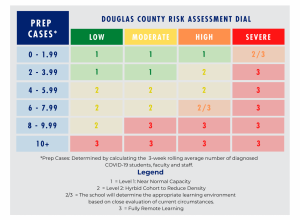COVID Matrix – What Does it Mean?
October 20, 2020
 As Prep administrators have developed a flexible plan that will guide decisions regarding the capacity level that the school will operate under. The matrix (shown right) used to aid administrators in making these determinations is made up of two data inputs.
As Prep administrators have developed a flexible plan that will guide decisions regarding the capacity level that the school will operate under. The matrix (shown right) used to aid administrators in making these determinations is made up of two data inputs.
The first is the risk level indicated by the Douglas County Risk Assessment Dial. This severity level is updated weekly by the Douglas County Health Department and is calculated based on the number of positive tests in the county and the percentage of tests that come back positive among other factors. The Prep administration uses this severity level as an estimation of the health of the wider Omaha community.
In addition to this metric provided by the Douglas County Health Department, the matrix also takes into account the Prep community’s case count in the form of a 3-week rolling average. This number is calculated by adding together any positive cases among the students, faculty, and staff in the prior three weeks, and dividing by three. This is meant to give an estimate of both the number of cases within the Prep community, and the number of quarantines as a result of those positive cases.
Example:
Week 1- 3 cases
Week 2- 1 case
Week 3- 2 cases
= 6 total cases
6 cases /3 weeks = 2.0 (3-week rolling average)
So what does this mean for the Prep community? Primarily it means that if Prep’s trends deviate from those of the wider community- administrators can make a call that makes more sense for Prep’s case level. For instance, if the Douglas County Risk Assessment Dial reads high, but Prep’s 3-week rolling average is below two, it doesn’t make sense for Prep to move to hybrid or full online because the case count within the school is relatively low. This model gives administrators much more flexibility in making decisions like this one because both the conditions of the wider community and the Prep community are taken into consideration.
A point of confusion for many in this system is the transition time between levels. If administrators believe that a transition from one level to another is necessary, there will be a transition period of a few days for both students and teachers to become acquainted with the new style of learning.
Administrators note that while the matrix is comprehensive, it is ultimately a guideline, and one of several tools used to gauge the risk to students and staff. This model will be used at least till the end of the first semester, and could be revised to fit any new challenges that the school may face in the future.




